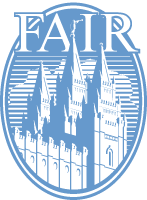

Francis Scott Key's original manuscript copy of his "Star-Spangled Banner" poem. It is now on display at the Maryland Historical Society. (Click for larger view)
It was exactly 197 years, 9 months, and 20 days ago that one of the most revered poems in American history was written. On the morning of September 14, 1814, a young 35-year-old lawyer and amateur poet by the name of Francis Scott Key stood on the deck of a ship at dawn and looked out over the water of Chesapeake Bay, Maryland. There he saw in the sky, waving proudly in the morning light, a large American flag flying triumphantly over Fort McHenry. At that moment he knew that our country, the young United States of America, had been victorious in the intense and passionate battle with the British the night before.
Francis reached into his pocket, and pulled out a letter he had, and on the back hand side began to pen these inspired words:
O say can you see by the dawn’s early light,
What so proudly we hailed at the twilight’s last gleaming,
Whose broad stripes and bright stars through the perilous fight,
O’er the ramparts we watched, were so gallantly streaming?
And the rockets’ red glare, the bombs bursting in air,
Gave proof through the night that our flag was still there;
O say does that star-spangled banner yet wave,
O’er the land of the free and the home of the brave?

The 15-star, 15-stripe "Star Spangled Banner Flag" which inspired the poem, now on display at the Smithsonian's National Museum of History and Technology. (Click for larger view)
On the shore dimly seen through the mists of the deep,
Where the foe’s haughty host in dread silence reposes,
What is that which the breeze, o’er the towering steep,
As it fitfully blows, half conceals, half discloses?
Now it catches the gleam of the morning’s first beam,
In full glory reflected now shines in the stream:
‘Tis the star-spangled banner, O! long may it wave
O’er the land of the free and the home of the brave.
And where is that band who so vauntingly swore
That the havoc of war and the battle’s confusion,
A home and a country, should leave us no more?
Their blood has washed out their foul footsteps’ pollution.
No refuge could save the hireling and slave
From the terror of flight, or the gloom of the grave:
And the star-spangled banner in triumph doth wave,
O’er the land of the free and the home of the brave.
O thus be it ever, when freemen shall stand
Between their loved home and the war’s desolation.
Blest with vict’ry and peace, may the Heav’n rescued land
Praise the Power that hath made and preserved us a nation!
Then conquer we must, when our cause it is just,
And this be our motto: “In God is our trust.”
And the star-spangled banner in triumph shall wave
O’er the land of the free and the home of the brave!


 It is significant to note that this year that you don’t have to travel to Sandy, Utah, to take part. The conference will also be available online via live video/audio streaming! You can sit in the comfort of your living room, or even on-the-go via your mobile smartphone or tablet, from anywhere in the world, and take part in this excellent conference. This news comes direct from FAIR:
It is significant to note that this year that you don’t have to travel to Sandy, Utah, to take part. The conference will also be available online via live video/audio streaming! You can sit in the comfort of your living room, or even on-the-go via your mobile smartphone or tablet, from anywhere in the world, and take part in this excellent conference. This news comes direct from FAIR:



